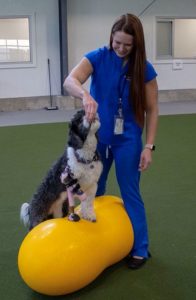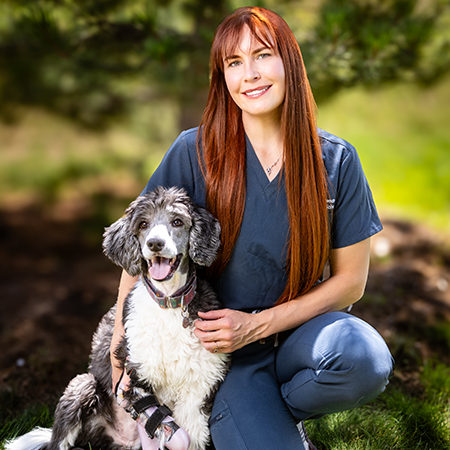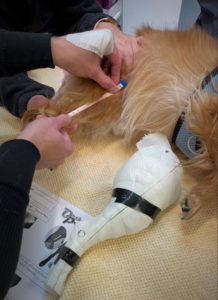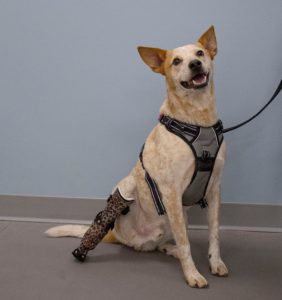 What is Sports Medicine?
What is Sports Medicine?
Sports Medicine & Rehabilitation was developed to meet the unique needs of the athletic and working animals, as well as all animals in need of rehabilitation. Rehabilitation (the term used for people is “physical therapy”) not only focuses on recovery after surgical procedures, but also improving the quality of life in animals suffering from debilitating diseases such as arthritis or neurological impairments.
The Sports Medicine and Rehabilitation service specializes in diagnostics and non-surgical management of lameness, injury prevention, conditioning, rehabilitation, and pain management. Our team will evaluate your pet and prescribe a personalized treatment plan for each patient. We use some of the most advanced therapies in pet rehabilitation today to help get your animal’s physical mobility to an optimal level of function.
What kind of conditions are seen by Sports Medicine & Rehab?
We help a wide spectrum of patients with various levels of mobility issues ranging from performance lameness of canine athletes to rehabilitation and pain management of osteoarthritis in older dogs and cats.
|
|
|
|
|
|
|
|
|
|
|
|
Diagnostics:
- Bloodwork
- CT Scan
- OFA, PennHIP & Radiographs
- Musculoskeletal Ultrasounds
Medical Treatment Options & Regenerative Medicine:
- Platelet rich plasma (PRP) – This is a treatment option for arthritis, tendon and ligament injuries. These therapies utilize the dog’s own cells to regulate pain and improve tissue healing through the process of immunomodulation. Under sedation the PRP is injected directly into the injured joint or tissue where it communicates with the local tissue environment to stimulate the body’s natural healing process.
- Joint injections (steroid and hyaluronic acid) – Hyaluronic acid is a naturally occurring fluid inside all living organisms. As a joint protective agent, HA is beneficial in lubricating joints, decreasing inflammation and degradation, and repairing cartilage. Intra-articular HA has been widely used to treat osteoarthritis in both large animals and humans. Several experimental studies have demonstrated its effectiveness in treating dogs with osteoarthritis.
- Acupuncture – Acupuncture is the stimulation of specific points on the body with a thin sterile needle in order to cause a therapeutic effect. The acupoints that are stimulated induce the release of beta-endorphins, serotonin, and other neurotransmitters. Studies have shown that some of the physiological effects of acupuncture are pain relief, anti-inflammatory effects, antifebrile effects, immunoregulation and the promotion of tissue healing.
- Shockwave – shock wave therapy is a non-invasive treatment that utilizes high-intensity ultrasound waves to stimulate the body’s natural healing capacity. (There is no electrical “shocking” involved). Shockwave has been shown to speed bone and tendon healing in dogs. Shock wave therapy can also be effective in decreasing symptoms of arthritis.
What rehabilitation therapies are offered at CVSG?
Therapeutic Exercise (Modalities) – These are manual therapies that target affected muscles, nerves and other structures to help restore function. Exercises increase balance, proprioception, range of motion, muscle mass, muscle strength, promote weight bearing, and normal gait patterns.
Strength, coordination, flexibility and balance therapies – We utilize tools such as exercise balls, fit bones, peanuts and wobble boards.
Neuromuscular Electrical Stimulation (E-Stim) – E-Stim uses low levels of electrical current to stimulate nerves and muscles. This can block pain signals, reduce swelling, strengthen muscles and retrain the nervous system. It is often used after orthopedic surgery, in cases of spinal cord damage, or for muscle strengthening. TENS is a specific form of E-stim that blocks pain pathways in the nervous system and is often used postoperatively or for chronic pain.
 Underwater Treadmill Therapy – Underwater Treadmill Therapy is very beneficial to a wide variety of patients. The water buoyancy counteracts gravity, reducing concussive forces on the body. This allows the patient to walk comfortably in the water with decreased pressure on the joints. Water resistance aids in increasing muscle mass, muscle strength, circulation/blood flow, cardiovascular endurance, range of motion and weight bearing on an affected limb(s). The treadmill water is also heated to reduce stiffness and pain thus, further ensuring patient comfort.
Underwater Treadmill Therapy – Underwater Treadmill Therapy is very beneficial to a wide variety of patients. The water buoyancy counteracts gravity, reducing concussive forces on the body. This allows the patient to walk comfortably in the water with decreased pressure on the joints. Water resistance aids in increasing muscle mass, muscle strength, circulation/blood flow, cardiovascular endurance, range of motion and weight bearing on an affected limb(s). The treadmill water is also heated to reduce stiffness and pain thus, further ensuring patient comfort.
PEMF Bed – Pulsed electromagnetic field therapy is a non-invasive therapy that has been shown to decrease pain and speed healing. We offer PEMF therapy during many treatment sessions.
Vibe Plate – Designed with Whole Body Vertical Vibration to reduce muscle soreness and inflammation while increasing bone density, EquiVibe really gets the blood pumping. Improved circulation means better oxygenation of the tissues, removal of toxins and of metabolic waste. The vibe plate enhances the body’s ability to heal itself, drug free – because when your pet feels how they should, the rest comes naturally.
Therapeutic Laser Therapy – Laser therapy is used to improve wound healing, reduce post-trauma swelling, and facilitate long lasting pain relief by stimulating the release of your dog’s own pain killing chemicals like endorphins.
Massage Therapy – Therapeutic massage aids in decreasing pain, stiffness, edema, muscle knots/spasms, scar tissue, and increases circulation and helps to promote relaxation.
OrthoPets Partner
Custom made orthotic and prosthetic devices for pets, including braces for knee, ankle, wrist, elbow and more. Many clients are seeking an alternative for surgery, our skilled team will walk you through options to return your pet to full function.
What to expect
If you are interested in a knee brace, prosthetic, or splint for your pet the first step is to set up an initial evaluation with us. At that appointment we perform a thorough exam to confirm your pet is a good candidate for a brace or prosthetic.
We will take measurements and create a mold of the injured limb. Once the brace is finished we will have a fitting appointment and teach you how to place the brace on and how to help your pet adapt to walking in a brace.
Follow up appointments are required to ensure proper fit, prevent sores, make adjustments, and assist with returning to full function.




